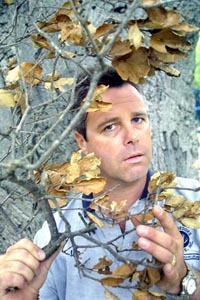![[Metroactive News&Issues]](/gifs/news468.gif)
[ San Jose | Metroactive Central | Archives ]
 Bough Down: Although sudden oak death appears to be devastating, San Jose Arborist Ian Geddes says such diseases are part of the cycle in nature.
Bough Down: Although sudden oak death appears to be devastating, San Jose Arborist Ian Geddes says such diseases are part of the cycle in nature.
Photograph by George Sakkestad
The Bite, The Bark A deadly pathogen is munching its way through the region's majestic tan oaks--and it's just getting started By Kristin Bartus and Kelly Luker YEARS FROM NOW, scientists may still be discussing Patient Zero; the original victim that lived in Mill Valley. Once healthy and vibrant, the patient sickened and died within months from a mysterious, fast-moving ailment. In this case, the victim was close to a hundred years old and a tree--an oak tree. That was in 1995, when no one had any idea how quickly the disease would spread. Over the past six years, tens of thousands of oak trees have died in California coastal counties from Monterey to Sonoma. The disease killing these trees is referred to as sudden oak death. Its cause is a new species of the pathogen Phytophthora. This pathogen, which is related to the one that caused the Irish potato famine in the 19th century, is a brown algae that functions like a fungus. "It colonizes the bark of the tree, eats that bark and basically kills tissue," explains Brice McPherson, a postdoctoral researcher in entomology at UC-Berkeley. "It shuts down the means that these trees have to nutrients." The most obvious symptom of the disease is bleeding from the bark. There are plenty of other diseases that infect oaks and the symptoms may be confusing. Anyone concerned about a tree should contact an arborist or go to www.suddenoakdeath.org. McPherson and more than a dozen other researchers at UC-Berkeley and UC-Davis are currently studying sudden oak death. The disease has spread to thousands and thousands of trees in seven coastal counties, including Santa Clara County. "It's a problem in mountainous regions," says San Jose arborist Ian Geddes. "It's mainly tan oaks, but we've seen the occasional live oak succumb." In the last two years he's seen about 15 cases, mostly in the Summit, Lexington and Skyline areas of the county. "We believe this is heading toward epidemic level," says Geddes. "It's very quick-acting--it can kill within a month." The arborist adds one more piece of sobering information: "We do not believe there's a way to stop it."
Photograph by George Sakkestad
Researchers do not yet know exactly how the disease is spread. They believe that the pathogen is airborne and can move from one tree to another via wind and rain. They speculate that the disease also can be passed through soil. "We assume that human traffic will and could have some part in this, but that is just due to analogous situations," says McPherson. Researchers feel that the disease could potentially be spread when hikers, bikers, dogs, horses or vehicles transport soil from an infected area to a noninfected area via their boots, tires, paws or hooves. In February some of the 200-plus members of the California Oak Mortality Task Force began putting up signs at trailheads throughout the 20,000 acres of the Marin Municipal Water District, urging trail users to wash off any soil before traveling to uninfected regions. There is enough concern at the state level that at the end of May, the California Department of Food and Agriculture (CDFA) added Oak Mortality Disease Control Regulations to their code. The regulations restrict any potential carriers of the disease from being transported. Those hosts include the black oak, coast live oak, Shreve's oak, tan oak, rhododendron, California bay laurel, madrone, huckleberry and arrowwood. Essentially, no processed or unprocessed products (including firewood, mulch and wood chips) from that vegetation are to be moved within an affected county or from there to an unaffected county. "Although we're not sure that these regulations will stop the spread of sudden oak death, we want to be safe because we don't know yet what causes the spread," says Steve Lyle, director of public affairs for the CDFA. Meanwhile, the task force continues to educate agricultural agencies and organizations as well as the public on sudden oak death. The disease poses a potential risk to trees both on parklands and in the yards of homeowners. Dead trees in parklands could become a fire danger. If oaks on private property fall victim to sudden oak death, homeowners could lose the much-needed shade the trees provide. In addition, it can be costly to remove the trees. Although the disease may appear to be devastating, Geddes is quick to remind others that this cycle in nature is not unusual. "Periodically, we see diseases run through a plant family," explains Geddes. "The most likely thing is [sudden oak death] is going to run its course through the tan oaks." [ San Jose | Metroactive Central | Archives ]
|
From the July 5-11, 2001 issue of Metro, Silicon Valley's Weekly Newspaper.
Copyright © 2001 Metro Publishing Inc. Metroactive is affiliated with the Boulevards Network.
For more information about the San Jose/Silicon Valley area, visit sanjose.com.
 Root of the Problem: Researchers think the disease can be spread by hikers, bikers, horses and dogs who track soil from one location to another.
Root of the Problem: Researchers think the disease can be spread by hikers, bikers, horses and dogs who track soil from one location to another.